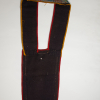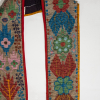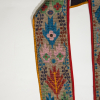Bandolier
Bandolier
Bandolier
















Bandolier, loom woven beadwork panel straps and nine tabs with yarn tassels, stroud, symmetrical and asymmetrical decorative beaded designs.
Read More About This Relative
Stroud, seed beads, bias tape, silk ribbon, yarn.
Stroud pouch panel bordered by yellow silk?, ribbon and edged with red bias tape, Ribbon and bias tape forms tabs at bottom corners, Yellow ribbon decorated with white applied beadwork in otter track design, Pouch has loom woven beadwork panel in a stylized floral design, vertically symmetrical, Fringe formed of nine loom woven beaded tabs, finished with red yarn tassels, Strap has loom woven beads in stylized asymmetrical floral design, Outer edging yellow bias tape, Inner edging red bias tape.
Otter track beading on pouch panel, Conventionalized rose and leaves, berry, zigzag, feather ?, stylized birds ?, veining of leaves, Tabs have geometrical designs repeated from centre out.
Bandolier adopted by Ojibwa in 19th century after seeing bullet pouches used by British soldiers. Bullet pouches were plain and decorated with crest or coat of arms. When idea adopted by Ojibwa, they were greatly prized and highly decorated ceremonial accessories. They became so highly prized by Ojibwa and other tribes (especially Sioux), that one bandolier could be traded for one pony.
Provenance
catalogue records
About This GRASAC Record
Manitoba Museum
 Knowledge Sharing Platform
Knowledge Sharing Platform















